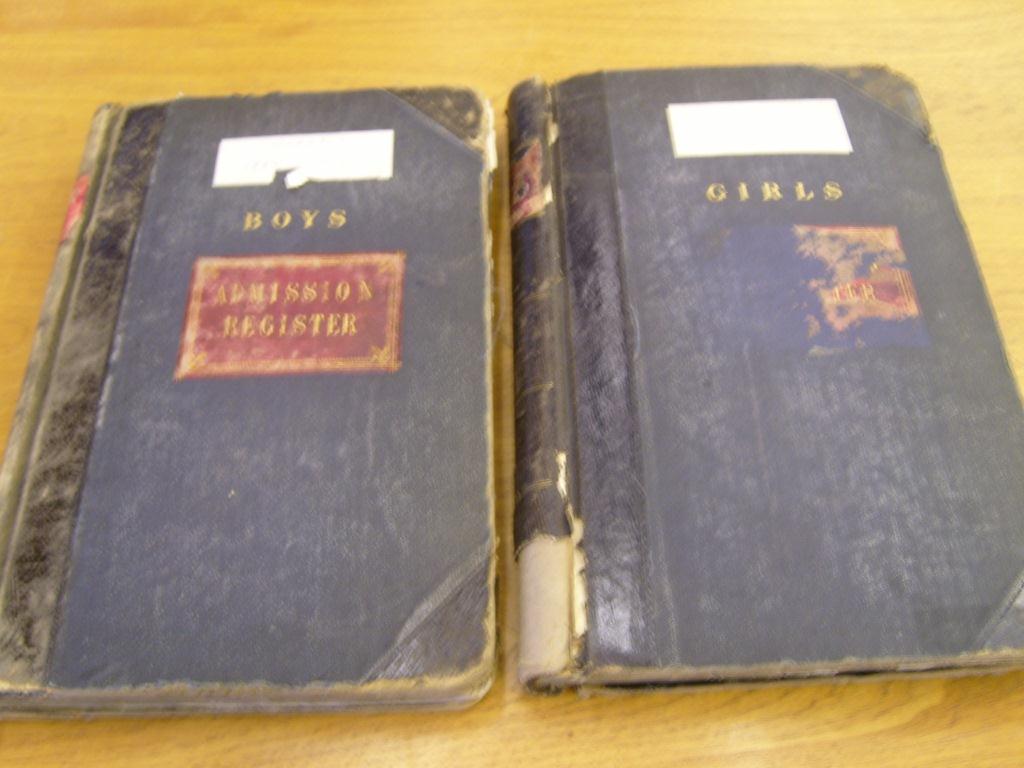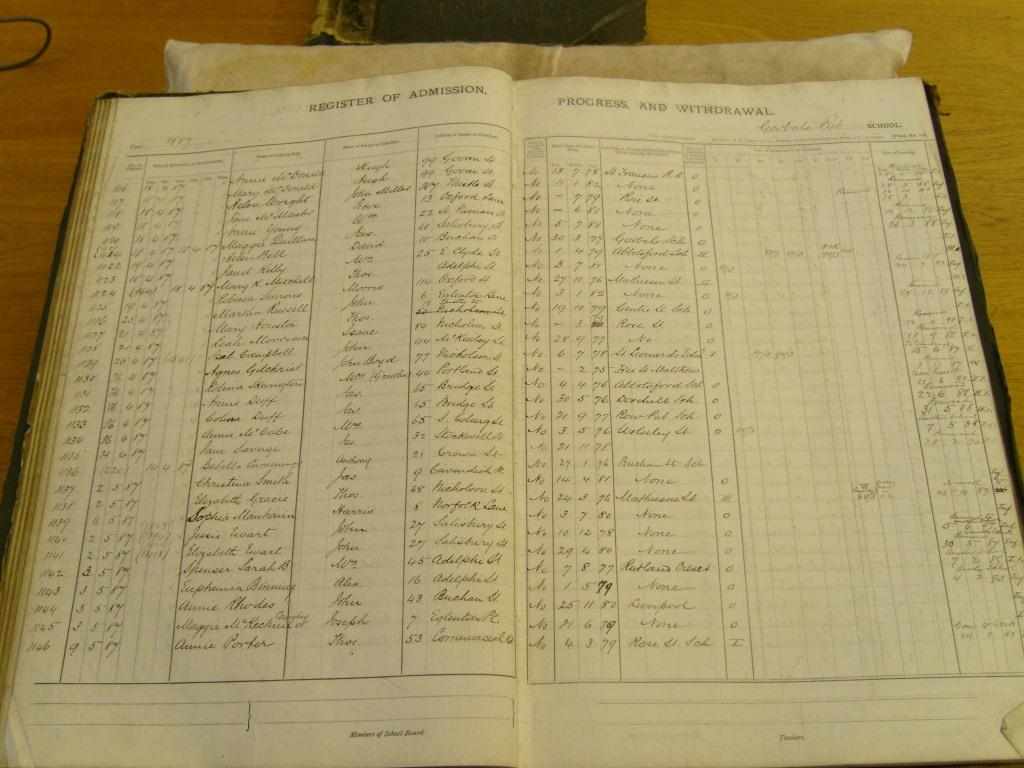JEWISH CHILDREN AT THE GORBALS PUBLIC SCHOOL 1885-1905
© Jeanette R Rosenberg

Gorbals Public School Admissions Registers. Boys and Girls.
Volume 1 1885-1905
Introduction
This is a database of the Jewish children who attended the Gorbals Public School
between 1885 and 1905. It uses data transcribed from the boys and girls school
admissions registers held at the Mitchell Library in Glasgow, Scotland,
www.mitchelllibrary.org. The
Mitchell Library holds four volumes of admissions registers for the Gorbals
School, two volumes each for the boys and two for the girls. Volume 1 covers the
years 1885-1905 and volume two holds the records from 1905 to 1919. Girls’
volume 1 contains 5402 pupil records and boys’ volume 1 contains 5432 pupil
records.

An inside view of the Gorbals Public School Register
More about
the Database
The database sits as a companion to Harvey Kaplan’s 2006 publication “The
Gorbals Jewish Community in 1901” and the Historical Database of Scottish Jewry
(HDSJ) at the Scottish Jewish Archives Centre (SJAC),
www.sjac.org.uk as a
resource for those researching immigrant Jewish ancestry.
In all likelihood, the data in the registers contains some errors, because the
initial information was provided by non-English speakers to people who were
unfamiliar with the spelling of Jewish and particularly Eastern European names
and who could not verify the data fully, also because not all register entries
were fully legible.
Some children are clearly in the database more than once, if they left and then
returned to the school sometime later. It was also found that from time to time
entries for girls could be found in the boys’ book, and vice versa. Normally the
erroneous entries were duplicated in the correct book and then struck from the
register, however within the data, there is one example of a boy being listed
within the girls register, whose entry was not duplicated in the other register.
What can I find out from this database?
Genealogically speaking, what makes this database of interest are the snapshots
of detail about the lives of the Gorbals Public School pupils. Frequently, the
register notes previous schools which range from those elsewhere in the Gorbals,
through, elsewhere in Scotland, Britain, or abroad. Schools in towns and cities
through Britain were concentrated in those areas with established Jewish
communities, which were predominantly also ports and centres of migration, such
as London, Hull, and Liverpool. Foreign locations included Russia, (with the
precise location of Wilna in one case), Austria, Germany and even America in
another, reflecting the migratory nature of Glasgow’s Jews. Unsurprisingly the
destinations of many of those leaving Gorbals Public School were similar.
Although many pupils departures from Gorbals Public School went unrecorded in
the register, or they left to start work, testifying they were old enough to do
so, it was interesting to note how few pupils left on grounds of ill health,
irrespective of the poverty in which they lived. Also how many moved home within
their local area and that for many, their next destination was America.
By using the data collected, it is possible to find detailed information about
Jewish families whose children attended Gorbals Public School. Not only can this
data be used to reconstitute families over a period of time using records other
than vital records, but also some of the families whose data is contained here
may have both arrived and left Glasgow between censuses, only staying long
enough for their children to attend school for a short time. The data can also
be particularly useful for tracing those born abroad, or who migrated
afterwards, because frequently it contains exact dates of birth and other
details not available elsewhere.
The detailed information available within the registers, such as precise dates
of birth for most children, is particularly useful for tracing those born
abroad. This level of detail is far greater than is otherwise available in
census and migration records, and can be invaluable in facilitating further
research, particularly in Eastern Europe, where many genealogists find data
access and genealogical research complex. Having access to exact birth dates can
also assist in honing in on particular individuals or families in other
immigration, emigration and transmigration records, especially where family
naming patterns are very similar.
Jewish Immigration to Glasgow
In the late nineteenth and early twentieth centuries, countless Jewish
immigrants settled in Glasgow, although many later moved elsewhere, and a very
high proportion of the children at Gorbals Public School were Jewish. Jewish
immigrants to Glasgow arrived, from Germany, Austro-Hungary and The Pale of
Settlement.
Most Jewish Glaswegians arrived initially in England, and then came north
because Jews were encouraged to Glasgow to help ease congestion in Jewish East
London. The first immigrant wave arrived in the 1880s forming the poorer Gorbals
section of the community and the next came in the 1890s. In 1908 about 10,000
Jews passed through Glasgow en route to America and during peak activity, up to
4 US-bound ships left Glasgow each month. 75% of Glasgow Jews were of Russian or
Polish origin, with relatively few from elsewhere, but by 1891, Jews from
Lithuanian Baltic Ports like Libau dominated.
School Log Books and Admittance Registers
The 1872 Scottish Education Act made school attendance compulsory for children
aged 5-13 and admissions registers are a good source of information about
pupils, because teachers were obliged to keep registers and daily logs of school
occurrences. Few early registers and logs survive and the value of the
information they contain depends on the thoroughness of those completing them.
The registers are invaluable because even if a family was only in Scotland for a
few months, the children would have attended school to learn English and to get
them out from under their parents’ feet during the day, and there cannot have
been many Jewish children who escaped the school system completely. Admission
Registers can include pupil information such as date of birth, address, date of
admission and date of leaving.
Gorbals Public School
Gorbals Public School opened in 1885 enrolling many pupils who had previously
been at Buchan Street School, but after this, most pupils were new starters at
school. The numbers of Jewish boys and girls were roughly equal over the period
and rose considerably from 1896 onwards. School attendance figures depended on
birth rates and Glaswegian Jewish immigration peaked in 1891-2, which partly
explains the rise in school entrants thereafter.
Gorbals Public School contained a high number of Jewish children who all lived
locally. The school logbooks have notes in the margins written by the Head
Teacher about the low attendance by Jewish pupils at school during Jewish
festivals. In this database, the children selected for inclusion as Jewish
follow the criteria outlined by Kaplan (2006, p5-6), whereby Jewish is defined
in the wider sense rather than by Orthodox specifications.
The children attending the school lived in the surrounding area and were
concentrated in the closest streets. Most of the Jewish Pupils lived in the
following streets: Adelphi, Thistle, Main, Stockwell, Crown, Bridgegate,
Hospital, Govan, Nicholson, Oxford and Rose.
How can I
search this database?
To search the database, go to
the JewishGen UK Database page
/databases/UK/ and select
the Glasgow community in the JGSGB UK Database.
Search for the family names you are researching. If the search yields results
for the name you are searching, the results will show "Gorbals Public School
Registers ".
Context
This work was carried out in 2008 by Jeanette R Rosenberg in fulfilment of the
Postgraduate Certificate in Genealogical Studies at the University of
Strathclyde, Glasgow, Scotland
www.strath.ac.uk/genealogy.
If you have a question or are interested in reading more information about the
project are invited to
contact Jeanette. Please note, Jeanette does not have any additional
information about the people whose names are held within the database.
Jeanette would like to thank the following for
support during the research and writing of her project:
Mark Nicholls, for photography, and
assisting with transcription;
Harvey Kaplan, Director, Scottish Jewish Archives Centre, for encouragement and
signposting;
Dr Nicholas Evans, Hull University, whose lectures about transmigration inspired
this project;
Dr Irene O’Brien and her colleagues at The Mitchell, who permitted this project
to proceed and made us welcome during transcription.
Audrey Wyper, Dr Bruce Durie and Graham Holton of Strathclyde University, for
their support and guidance during the project.
Glasgow Jewish
Community page
Page created by Louise Messik: 24 October 2010
Page most recently amended: 15 September 2024




